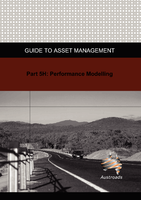Asset Management

- Publication no: AGAM05H-09
- ISBN: 978-1-921551-59-8
- Published: 22 July 2009
- Edition: 1
- Superseded
- PDF (free) Download
Guide to Asset Management Part 5H provide guidance on the selection, formulation and calibration of pavement performance models for application in the management of road networks. The modelling considered is intended to facilitate reporting of current conditions and life-cycle predictions of future pavement performance for application in the management of road networks. The modelling considered extends from static models for the derivation of composite indicators (such as key performance indicators, KPIs) from a range of individual measures, through to future prediction using comprehensive dynamic pavement performance modelling of functional, structural, and works effects. The models include strategic models based on a few individual measures and significant input parameters which may be used to provide broad estimates of current and future conditions, through to more detailed modelling of functional and structural conditions, and works effects involving interactive component incremental models.
- Austroads membership
- 1. INTRODUCTION
- 1.1. Guide to Asset Management
- 1.2. Objective and Structure of Part 5H of the Guide
- 2. OVERVIEW OF PERFORMANCE MODELLING
- 2.1. Role of Performance Prediction in Asset Management
- 2.2. Role and Requirements of Modelling Performance at a Network Level
- 2.3. The Place of Performance Modelling in Pavement Management
- 2.4. Parameters for Pavement Performance Modelling
- 2.4.1. Pavement Performance Measures
- 2.4.2. Factors Influencing the Modelling of Performance Prediction
- 2.5. Sources of Performance Data
- 2.6. Application of Performance Measures and Prediction Models by Australasian Road Authorities
- 3. PERFORMANCE CONCEPTS AND MEASURES
- 3.1. Primary Response Measures
- 3.2. Individual Structural and Surface Distress Measures
- 3.3. Pavement Damage Factors
- 3.4. Functional Performance Indices
- 3.5. Structural Performance Indicators
- 3.5.1. Measures
- 3.5.2. Relation to Traffic Load
- 3.6. End of Useful Life
- 3.7. Application and Development by Australasian Road Authorities
- 3.7.1. Common Surface Condition and Ride Quality Related Measures
- 3.7.2. Structural Condition Measures
- 3.8. Summary
- 4. PERFORMANCE MODELLING APPROACHES
- 4.1. Deterioration Modelling Approaches
- 4.1.1. Probabilistic Approach
- 4.1.2. Deterministic Approach
- 4.2. Examples of Available Deterministic Models and their Adaptation to Australasian Conditions
- 4.2.1. Scope
- 4.2.2. Time Based Models
- 4.2.3. Empirical Regression Based Models
- 4.2.4. HDM-III and HDM-4 Mechanistic-empirical Models
- 4.2.5. Alternative Mechanistic-empirical Component Models
- 4.3. Application and Development by Australasian Road Authorities
- 4.3.1. Time Based (Family of Curves) Model
- 4.3.2. HDM Model Implementations
- 4.3.3. The New Zealand dTIMS Model
- 4.4. Works Effects Modelling
- 4.5. Summary
- 5. MODEL LIMITATIONS AND SPECIAL TECHNIQUES FOR MODEL DEVELOPMENT
- 5.1. Model Limitations
- 5.2. Use of Simplified Independent Variables
- 5.3. Calibration and Validation of Performance Models
- 5.3.1. Model Validation
- 5.3.2. Model Calibration
- 5.3.3. Example Results of Australasian Calibration Studies
- 5.4. Experimental Design for Developing Performance Models
- 5.4.1. Experimental Testing Design
- 5.4.2. Design for Observation of Performance
- 5.5. Analysis Techniques for Modelling Pavement Performance
- 5.6. Modelling of Road Networks
- 5.7. Summary
- REFERENCES
